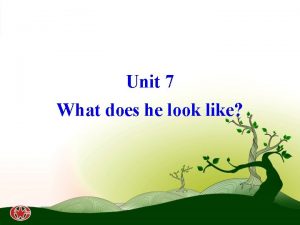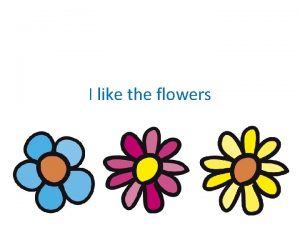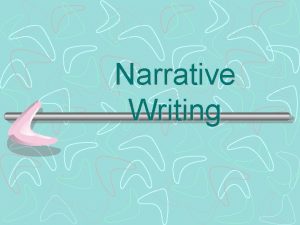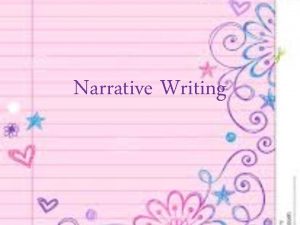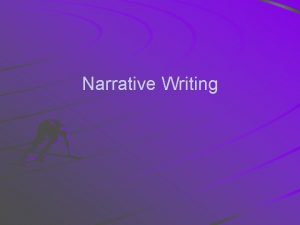Narrative Writing Writing a Narrative q Like a








- Slides: 8

Narrative Writing

Writing a Narrative q. Like a narrator in a story, when you are asked to write a narrative you are being asked to write or tell a story.

Writing a Narrative Essay q Use your imagination. q Have a good idea for your story q Tell the COMPLETE story. q Have a conflict that you will resolve. q Include enough details so your reader understands your story. q Have a logical conclusion. q Use correct grammar and spelling!

What will you have to write about? q. Given a brief description of a situation. q. Then, you will be asked to think about what you feel might happen as the situation develops— q. BASICALLY, you need to write a story from the details given! q. Make sure your story makes SENSE and the reader knows EXACTLY what’s happening. q. Write about the prompt that is given! DO NOT write about an adventure to outer space if the prompt deals with a child having trouble in school.

10 Steps to “Narrative” Success 1. Create the setting: Make sure you include details to make your story more real. 2. Give each main character a personality: They each need names and traits. 3. Create the realistic main conflict: Think about possible situations/plots that will revolve around the main problem. 4. Create the plot (plan of action) 5. Develop the story: Think about the plot chart. . exposition, rising action, climax, falling action, resolution.

10 Steps to “Narrative” Success 6. Write the solution for the problem: Include the lesson that was learned! 7. Give your story a title!! ALWAYS! NO EXCEPTIONS! Make it creative!! 8. Include transitional words and phrases. 9. Consider ADDING DIALOGUE to help your reader understand the thoughts of the characters. 10. EDIT & SUBMIT: Check grammar & spelling, content, and make sure you don’t fall behind on time!

Format of Narrative Beginning Title • Grabber-Interesting opening • Intro. setting, characters, and background information • Get the action of the story started Middle (1 -3 paragraphs) • Include a conflict • Use dialogue to develop the characters and the plot • Include a climax - turning point End • Resolution-resolve conflict • Depict how the story ends. What happens to everyone or everything?

Brainstorming Method






